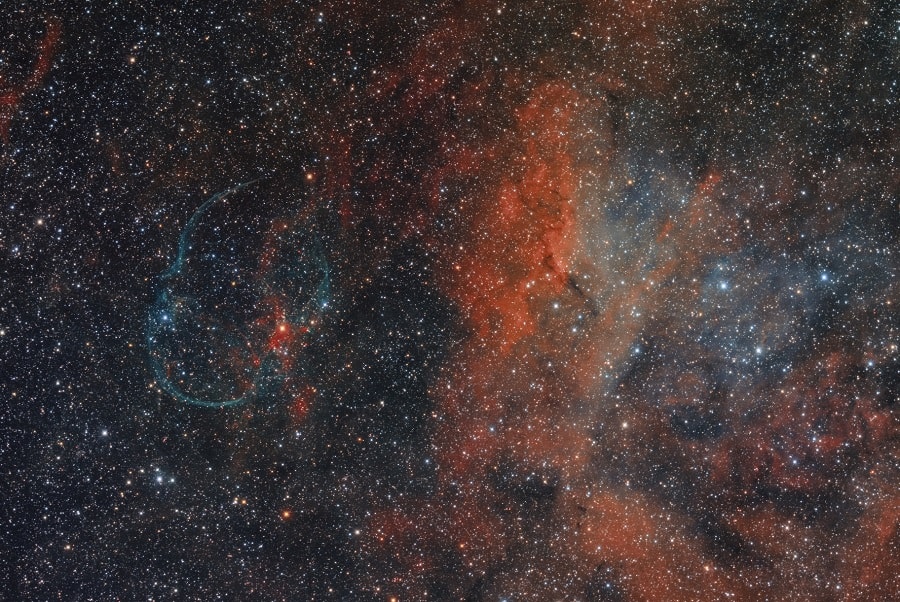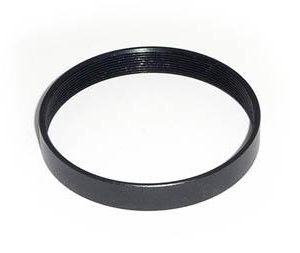QHY 600M PH – Versión FOTO. Cámara CMOS refrigerada.
Disponible en Monocromo y Color, con BFL standard o SHORT.
- QHY600PH-M – versión FOTO monocroma BFL 17mm.
- QHY600PH-C – versión FOTO color BFL 17mm.
- QHY600PH-M SBFL – versión FOTO monocroma BFL 12mm.
- QHY600PH-C SBFL – versión FOTO color BFL 12mm.
¿Interesado también en la rueda portafiltros QHYCFW3 y la guía fuera de eje QHYOAG?
Para las versiones PRO de la cámara QHY600, consúltenos en info@lunatico.es.
La QHY600 utiliza el más reciente sensor retroiluminado SONY IMX455, un sensor full-frame (formato de 35 mm) con 3.76um píxeles y A / D nativo de 16 bits, con un tamaño de 36 mm x 24 mm.
Con su diseño de cuerpo redondo, la QHY600 es una cámara ideal para combinar con el círculo de imagen de la nueva generalización de los telescopios RASA.
 Con la ventaja del bajo ruido de lectura y la lectura de alta velocidad, la tecnología CMOS ha revolucionado las imágenes astronómicas. Una cámara de imagen astronómica monocromática, retroiluminada y de alta sensibilidad es la opción ideal para los astrofotográfos. Sin embargo, durante años solo hemos visto las cámaras monocromáticas con iluminación frontal de 4/3 pulgadas (QHY163M) con un QE de aproximadamente el 60% y cámaras monocromáticas retroiluminadas de una pulgada (QHY183M) con un QE más alto. Aunque estos sensores son bastante buenos y muy adecuados para principiantes, aún son más pequeños que los sensores de fotograma completo (formato de 35 mm) deseados para una astrofotografía de cielo profundo más seria. Además, ambos sensores tienen A / D de 12 bits. Para lograr 1e- de ruido de lectura, debe aumentar la ganancia y perder cierto rango dinámico en el proceso, o usar ganancia baja y perder algo de precisión en los niveles de muestreo y escala de grises.
Con la ventaja del bajo ruido de lectura y la lectura de alta velocidad, la tecnología CMOS ha revolucionado las imágenes astronómicas. Una cámara de imagen astronómica monocromática, retroiluminada y de alta sensibilidad es la opción ideal para los astrofotográfos. Sin embargo, durante años solo hemos visto las cámaras monocromáticas con iluminación frontal de 4/3 pulgadas (QHY163M) con un QE de aproximadamente el 60% y cámaras monocromáticas retroiluminadas de una pulgada (QHY183M) con un QE más alto. Aunque estos sensores son bastante buenos y muy adecuados para principiantes, aún son más pequeños que los sensores de fotograma completo (formato de 35 mm) deseados para una astrofotografía de cielo profundo más seria. Además, ambos sensores tienen A / D de 12 bits. Para lograr 1e- de ruido de lectura, debe aumentar la ganancia y perder cierto rango dinámico en el proceso, o usar ganancia baja y perder algo de precisión en los niveles de muestreo y escala de grises.
La nueva QHY600 está a punto de cambiar todo esto. Se acabaron las cámaras CMOS que no son de 16 bits y las CMOS monocromáticas no «full frame» (y más grandes).
| Características destacadas: | QHY600 PH | |
| IMX455 Sensor Grade | -K (Industrial) | |
| Pixel Size | 3.76um x 3.76um | |
| Sensor Type | Back-Illuminated (BSI) | |
| Sensor Surface Glass | AR+AR Multi-Coated | |
| Effective Pixels | 61.17 Megapixels – (9576*6388 effective area. 9600*6422 with overscan and optically black area) | |
| Effective Image Area | 36mm x 24mm | |
| Full Well Capacity (1×1, 2×2, 3×3) |
Standard Mode : >51ke- / >204ke- / >408ke- Super Full Well Mode: >80ke- / >320ke- / >720ke- |
|
| A/D |
* QHY600 uses the software digital binning for 2*2binning. With digital sum, 2*2binning will be four 16-bit summed then it is 18-bit. |
|
| Sensor Size | Full Frame Format | |
| Frame Rate | USB3.0 Port Image Transfer Speed
|
|
| Read Noise | 1.0e- to 3.7e- (Standard Mode) | |
| Dark Current | 0.0022e-/p/s @ -20C 0.0046e-/p/s @ -10C | |
| Zero Amplifer Glow | Si | |
| Exposure Time Range | 40us – 3600sec | |
| Shutter Type | Electric Rolling Shutter | |
| Built-in Image Buffer | 2 GBytes(16Gbit) | |
| Cooling System | Dual Stage TEC cooler:
|
|
| Anti-Dew Heater | Si | |
| Telescope Interface | M54/0.75 | |
| Optic Window Type | AR+AR High-Quality Multi-Layer Anti-Reflection Coating | |
| Power | 40W/100% – 20W/50% – 13.8W/0% | |
| Back Focal Length | 17.5mm (±0.2) | |
| Length (w/dovetail ring) mm | 112 | |
| Weight (net)
* M54/0.75mm center/tilt adjust adapter not included |
850g* | |
| Diameter mm | 90 | |
| DDR3 Image Buffer | 2GB | |
| QHY filter wheel socket | Si | |
| USB 3.0 | Si | |
| Humidity/Pressure sensor | Si | |
| Short back focus option | Si | |
| Water cooling option | Si | |
| ACC Socket | No | |
| Upgrade to full PRO option | No | |

Monoceros en SNR G206.9+2.3 El cinturón de Orion La cabeza de caballo |
Comparación de los sensores monocromáticos de formato 35 mm IMX455 y KAI11002: consulte la comparación en https://www.qhyccd.com/index.php?m=content&c=index&a=show&catid=23&id=262

Documentación:
- Descargas
- QHY600 Linearity Test
- New Technology in the QHY600 and QHY268C
- QHY600 review from Galactic Hunter – Our Dream Camera for Astrophotography!
- FAQs
-
-
-
-
- 1.
¿Soporta el bining la QHY600?
-
-
-
-
- The CMOS sensor itself has some binning function but it should not be the hardware binning (FD binning). And also the binning in the sensor is based on the location of the Bayer color. it means it will binning with the same position of the same color. And for the monochrome QHY600 sensor, it still uses such a position to do binning. So we think it is not a good solution for the monochrome binning.
-
- And since the very low readout noise of the QHY600, so the digital binning may bring more advantages. First, it can increase the full well. Binning at 2*2 will gives four times the full well. Second, it will increase the AD sample depth. Binning at 2*2 will give an 18bit data range. For readout noise, the N*N digital binning will cause the readout noise to become SQR(N*N)= N times. For example, if the readout noise is 1.9e at 1*1 binning. The 2*2 digital binning readout noise will become 1.9*SQR(2*2)=3.8e.
-
-
-
- 2.
What’s the absolutely QE of QHY600?
-
-
-
-
- SONY does not release the official absolutely QE curve of the sensor. There is only a relativity QE graph. (Can be found on QHY600 specification page). But we did some experiment of testing the absolutely QE of QHY600 by comparing it with a known QE sensor. The article can be found at
https://www.qhyccd.com/index.php?=content&c=index&a=show&catid=23&id=261
-
-
- The current test results show a very high QE, it looks too high. We will find more sensors to do this work again.
-
-
-
- 3.
How to set the gain, offset and read mode at the first using
-
-
-
-
- For first using, we recommend this value: readout mode = #0 gain=26 offset=10. Here is an article for gain/offset setting at
https://www.qhyccd.com/index.php?m=content&c=index&a=show&catid=23&id=22
-
-
-
-
- 4.
Meet «Out of Memory»
-
-
-
-
- Please make sure the QHYCCD SDK had been updated to the last version. 2019.10.8 (V6.0.3) or later. The previous two versions has a memory leak bug and it will cause more memory loss. And if it is still out of memory, it may be the memory not enough in 32bit memory space. Since the 61mega pixels, the QHY600 requires big memory. The SDK will use about more than twice of the size of the image data (in the mono version it is 120MB per frame. so SDK need about 300MB, for the color version it is 360MB per frame, so the SDK need about 800MB) And the image acquires software need one or more. For the x86 system, the total memory space is 4GB, many other X86 software will take this space so it may be not enough memory there. We recommend using the x64 software, like the X64 SharpCAP, X64 N.I.N.A software. If you are using the X86 software. it is best to close other software to reduce the 4GB space
usage.
-









